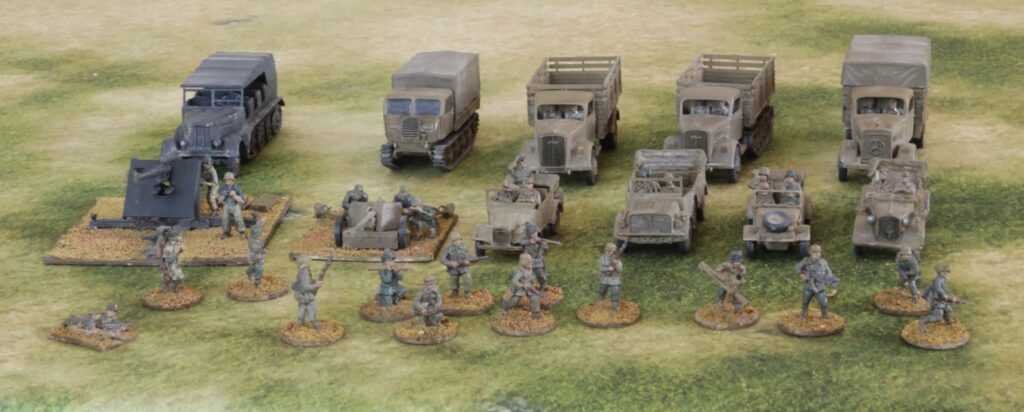
I’ve been off line here for nearly three months. At first I was pushing on with my Napoloenic rules project. I reached the point where it needed play testing – and then got distracted. I then moved on to my next project, which was to build more 20mm ground forces for the 1943 Mediterranean campaigns. These are 9 vehicles, two artillery pieces and 14 infantry figures, all German. At least twice I lost momentum as the project progressed, and I got distracted by other things. So the whole thing took quite a few weeks. I have been going for bigger projects to get more stuff done more quickly – but you can overdo it. This one was too big and complex, causing the fatal loss in momentum.
Looking back on it there were two main problems. First was combining infantry (AB metal figures) with model vehicles/guns. The processes between the two are too dissimilar, so for almost every session it was either on one or the other. Even though the models featured crew figures, these were much simpler than the infantry – and the artillery crews had different uniforms anyway. The second problem was that many of the models took far longer to assemble than I expected. The main culprit were the three Milicast cars, which are resin models with a number of fiddly parts and no assembly instructions. The Airfix Vintage Classics 88mm gun and tractor was also a nasty model to put together – mainly because the parts were ill-fitting. By contrast the Plastic Soldier Company (PSC) models (three medium trucks, a Raupenschlepper, and a Pak 40) were simple models that were quick to assemble. The S-Model Kubelwagen was somewhere in the middle. It was quite fiddly (more parts than then the Milicast ones), but in polystyrene, with well fitting parts and with clear instructions, so it was much easier to assemble. Painting and finishing a vehicle batch of this size was not a problem, however, even with two different colour schemes.
I will describe the project in three parts: the vehicles (and artillery) in this post, followed by the infantry, and a digression into dunkelgelb, principal vehicle colour.
The four cars

These vehicles (Horch Kfz 15 and 69 heavy cars, Stoewer Kfz 1 and VW Kubelwagen field cars) will be used as transport for small command, comms and observer groups. The two Horch cars (especially the large Kfz 69, really a light truck) are also suitable as tows for lighter field weapons, such as the Pak 38. The 69 could transport a small infantry squad too. All except the Kubelwagen are from Milicast. This is one of the two suppliers I am using for slightly more obscure vehicles and equipment; the other is SHQ, who make metal models. Both are in 1/76, so on the small side. I’d prefer 1/72, as these work better with the AB metal figures I like to use, but there is quite limited availability at this scale. The Milicast models are in resin – which can produce very fine detail, but is a bit fragile. I fell in love with the pictures of these vehicles on the website and got a bit carried away. I bought three SHQ metal models at about the same time (back in 2019), but was a bit disappointed. I have assembled a jeep and a Loyd carrier (a Bedford truck is still awaiting assembly), and found them a bit crude. The parts weren’t especially well-fitting. The end result was more than acceptable though.
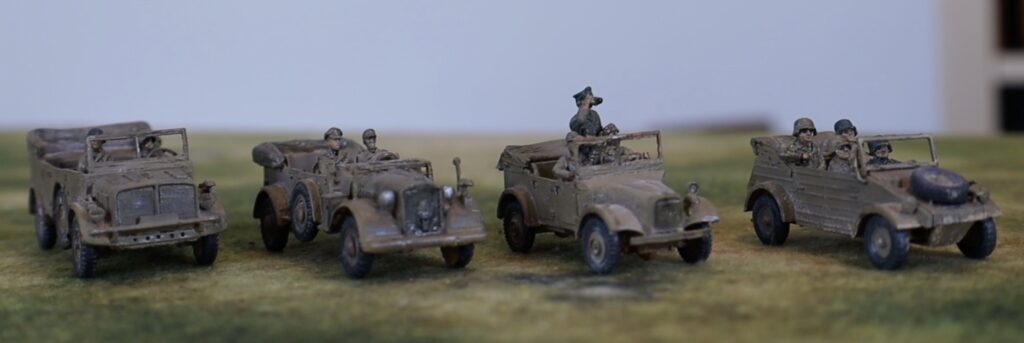
What I discovered this time was just how difficult resin is to work with. It didn’t help that the crew figures were resin too (bought separately from Milicast), and often needed arms to be glued in place. For each of the vehicles, the body came in one piece, but wheels, windscreens, lights, mirrors, steering wheels and various other bits, depending on the model, had to be glued on. I faced four main problems. The parts were fragile; they were often tiny; there were no recesses to secure them; and gluing was a bit tricky. On the final point I used standard cyano superglue. It look longer than expected to harden; the (usually tiny) part often needed to be I held in place for few minutes, and wasn’t properly secure until the next session. By a miracle no parts were lost in assembly, though some did go awol for a bit. At least one of the of the front lamps broke off at later stage, and I did not even attempt to search for it. Trying to clean flash off the windscreens was a nightmare, given the fragility the material – and one of them broke into several fragments that had to be reassembled. The upshot of all this is that these three cars took several two -hour sessions to assemble. I was vowing “never again” at the end. Come back SHQ, all is forgiven! Alas I have two more Milicast models awaiting assembly: a 17pdr antitank gun, and a 2cm Flakvierling (with quad barrels) which looks a complete nightmare, though this time with some assembly instructions.
The fourth car is the classic Kubelwagen. I actually have no less then four models of this vehicle (only one assembled) from old 1970s Airfix reconnaissance sets – but these were so terrible as to be unusable. They are tiny, and you couldn’t fit 1/76 figures in, never mind ABs – they came with some very diminutive crew figures, so it would have been obviously wrong to the designers. Those were the days. Instead I bought an S-Model kit in 1/72 – there are two models in each box, and I am saving he second one for later. To my relief the model proved big enough to take an AB crew of four figures specifically designed for the Kubelwagen – which fitted quite nicely. This wasn’t a particular simple kit, but in plastic, and with well-fitting parts (mostly with recesses to aid fitting), it was much easier than the resin models.
The medium trucks

From one extreme to another! These models came from a single box from PSC, designed with wargamers in mind. They are in 1/72, but originally engineered for 15mm scale (i.e. about 1/100), so they are quite chunky. There aren’t many parts, and no fiddly bits (no wing mirrors, and with headlamps crudely folded onto the mudguard, for example). They were very quick to assemble. The only complication was that I had to paint the interior of the cabs before assembly, which meant assembly of this bit was delayed. By the time I got there some of the parts had bent a bit out of shape, so the fit wasn’t as good as it should have been.

As is generally the case with PSC, there were multiple options – leaving a lot of unused parts at the end. There were two choices each for cab (Mercedes or Opel), drive (wheeled or half-track) and bed (higher sided without tilt or lower with tilt). As you can see from the picture, I tried each of these variations out.
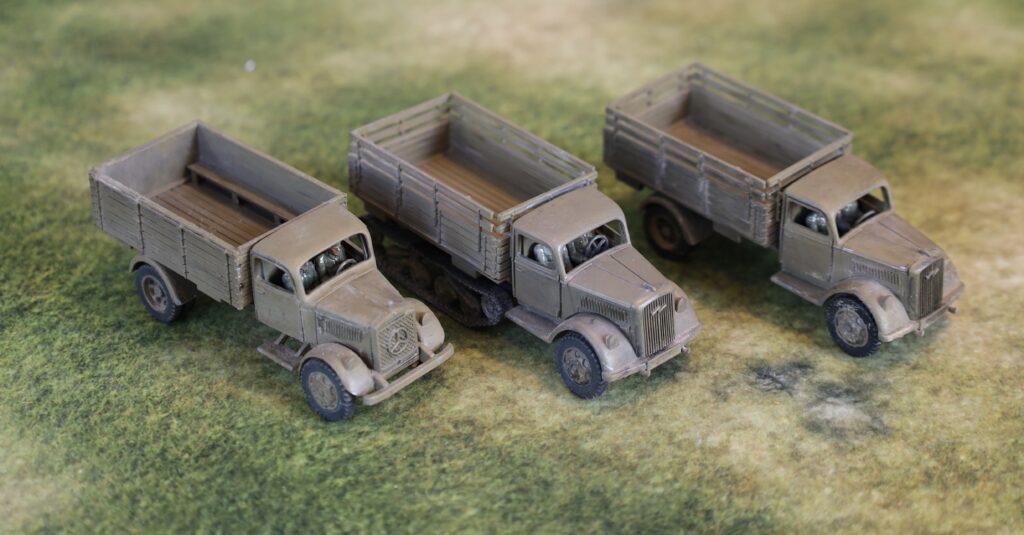
These aren’t fine models, but work well enough for tabletop gaming, and I’m really pleased with them. On the strength of this I bought a second box (PSC models are often out of stock, so it’s best to buy while you can). I have an idea of converting one of them to take a Flak gun on the back. Otherwise these vehicles are versatile as troop transports (the German troops in this theatre were usually motorised), tows for medium-sized guns, or supply vehicles (although there is limited call for these on the tabletop).
Raupenschlepper and Pak 40
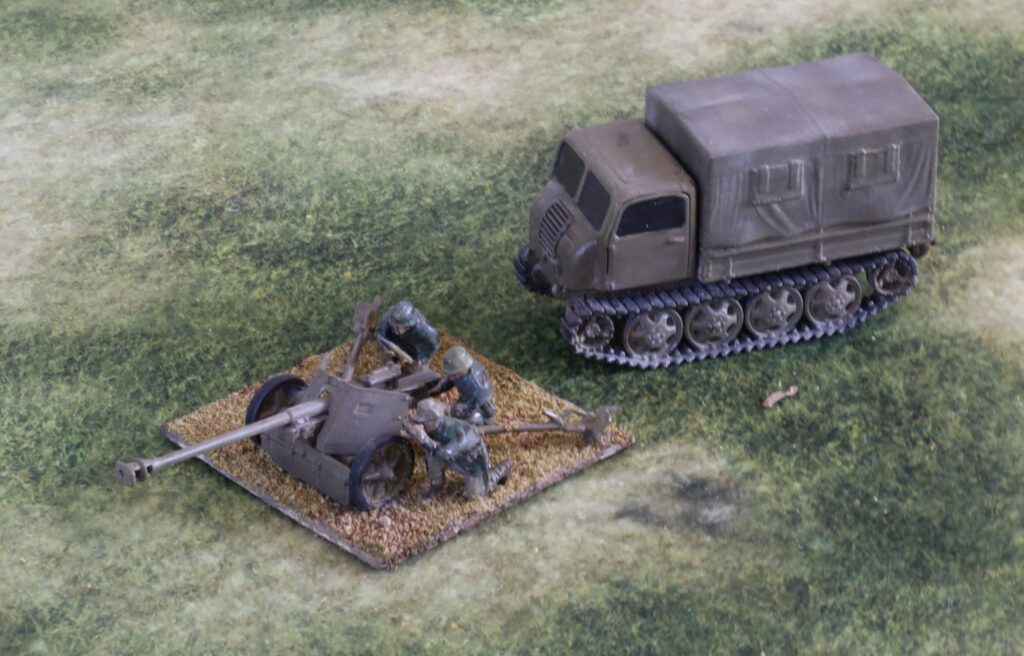
This is also a PSC kit. I needed Pak 40 75mm antitank guns, as these, according to some sources, were used in Tunisia (I’m not sure but Pak 36(r) converted from Russian 76mm guns, which used Pak 40 ammunition, definitely was in Tunisia), and by Salerno they seem to have been the standard antitank weapon in use by the Germans. The model comes with the Raupenschlepper Ost as a tow. I haven’t seen any pictures of this vehicle in use in this theatre, but Wikipedia has a picture of it in Albania in September 1943, so presumably it was around. It was designed for the Russian front, and used as a tow for medium weapons – it is usually pictured with the 10.5cm howitzer.
This isn’t such a good buy as the trucks. There are only two sets of models in the box. The Raupenschlepper has an alternative cab, with flat-panel construction used later in the war. There are also parts for a version used as a self-propelled Pak 40. Very few of these were actually built, so why all that plastic was used in a model designed for wargames use is a puzzle. I’m not especially a fan of the solid windows – though these looked much better in the end result than I feared. The tilt is moulded in two parts, and the join needed filing and puttying so as not to look too obvious. The crew figures for the Pak 40 aren’t very nice. These are standard PSC sprues, which I also had for the Pak 38s, with some figures requiring assembly. Somehow these are much harder to get looking lifelike than the AB cast figures, though these are quite expensive. They are depicted wearing smocks, which I painted up as early pattern German camouflage (though this is perfectly in keeping with the theatre).
Still the models were easy to assemble and the result is perfectly satisfactory. I’ll do the second models later.
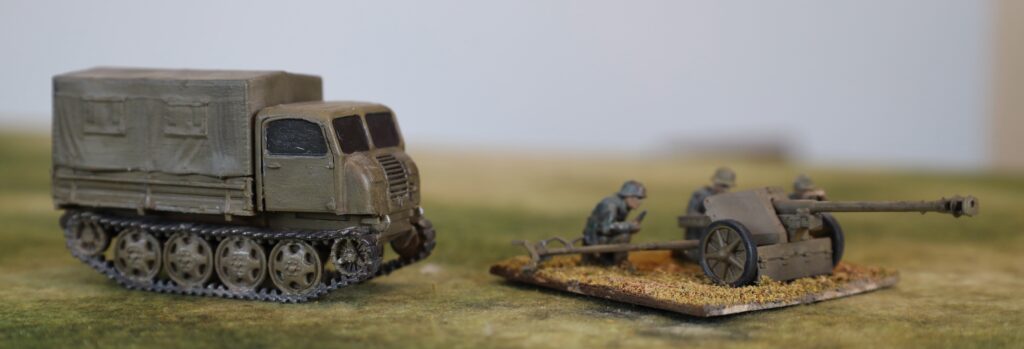
88mm Flak gun and Sdkfz 7

This was a bit of a disappointment. I bought the model from the Airfix Vintage classics range (see my 2018 post here) – in fact I bought two of them. They looked good value as I remembered them as being decent models back in the 1970s, though the track wheels on the tractor were a bit awkward to assemble. I also bought crew figures from AB. But the parts fitted badly, which made assembly harder than it should have been. Each of the running wheels comes in two parts, and the track is flexible polythene. The tractor was not particularly easy to put together as a result. But the gun was a bigger problem. Back in the day I could get the wheels on and off and the side-riggers up and down so that we could have it in both deployed and in transport mode – but for this model the fit was not tight enough. I did paint the wheels, but in fact none of my artillery is in towed mode, so I decided not to use them. The gun does not fit snuggly into the cradle. But worst of all the fit of the gun into the base was loose. This mattered because I attached a metal seated figure to it, which meant that the assembly tilted over to that side. In the end I had to feed plasticine into the hole in the base to help hold it in the upright position. The model comes with a shield, not shown the in picture here, as this was often not used. I had to cut a hole in it so that the seated crew figure and use his range-finder.
I decided to paint this in pre-1943 colours of “panzer grey”. Photos, even from the later war, often show 88s quite dark. The narrative here is that this is an old weapon brought forward from a rear area for front-line use, which nobody had repainted. The crew is Luftwaffe, who had slightly different ways of doing things. The AB crew figures are excellent, and the scale difference isn’t jarring. I painted them in slightly different colours to the infantry to reflect the Luftwaffe provenance.
I don’t think I will bother the second gun. I do have the crew for a second 88, but I will source this elsewhere – as a later variant of the weapon if I can get it. I will assemble the second tractor at some point, as it looks OK when finished. It can be used with any second 88, or with a towed 15cm howitzer if I get one.
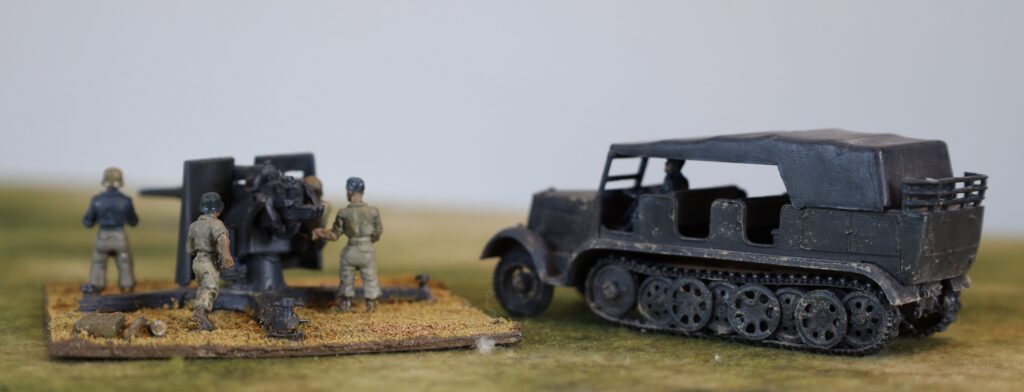
Painting and finishing
Step one was primer, which I applied after assembly (except of the cabs of the trucks. I wanted something quite dark, so that it wouldn’t show if the later painting did not reach all the recesses. To get into those recesses I used the airbrush. I used white airbrush primer paint mixed with darker acrylic paint (and some medium to make it more fluid). I used a brown for most of the vehicles, except the 88 and tractor, where I mixed in black. I’m still working on airbrush technique – and I’m being a bit frustrated with the tendency of the nozzle to clog – so the phase took longer than expected. Getting into the recesses was a bit harder than expected too. In future I will try to doing this differently. I have bought some Vallejo primer, with some in German dark yellow (and olive drab) – I will use this directly out of the bottle. I will also prime the parts before assembly, while still on the sprue – though still with the airbrush.
After this I painted the interiors and crews, so that I could finish assembly of the cabs. That done I painted the rest. This was simply one layer of the base colour applied by old-fashioned brush. As usual I mixed the colour using artists’ pigments – I will explain more how in a later post. The tyres, tracks and other detailing was then done. There were no decals. 88 barrels often have rings, presumably signifying claimed kills – but I couldn’t find anything suitable to use. I decided not to bother with number plate – and second line German vehicles such as these did not carry other markings.
After this I used the oil paint patina technique that I have been using on model aircraft. I dabbed small dots of oil paint onto the model – white, yellow ochre, brown, Payne’s Grey, black – and brushed it into a very thin layer. This softens the flat finish, giving it a rather worn appearance. It also gives the models a slight sheen, like new paintwork. I applied matt varnish to the tllts and the clothes of the crew. I am using a very old bottle of Windsor & Newton varnish, which is not reliably matt, but it looked OK. I then applied a glaze of dark mauve-grey that I was using on the infantry figures, to the crews and radiator grills. This left a slightly glossy finish, that will need a bit of touching up with matt varnish.
After this I used a metallic pencil (silver and pewter) to simulate exposed metal. Since the theatre was mostly dry, rust would be less prominent than vehicles elsewhere. The pencil works quite well, but the impact of this was not great, and I don’t think this is really worth bothering with. The exception may be on the tracks, though even this wasn’t very visible in the end.
Finally the vehicles got a dusting in – another technique learnt from model aircraft. Previously I used a specialist textured paint to simulate dust. This is quite thick and easy to overdo. It looked pretty good on the last batch of British vehicles I did; less so on the previous German ones. I tried putting some on a couple of the vehicles – including the dark grey Sdfz 7. I thought it was a bit too strong, especially on the dark grey. This technique works better to simulate mud than dust (though there was a lot of mud in Tunisia – not really in Sicily or Salerno). I then created dust from ground down artist’s pastel – mixing white, pale yellow and grey mainly. I then applied this generously with a paintbrush. It worked pretty well, though the process created clouds of pastel dust. A mask would have been a good idea, but I just held my breath. I am pretty pleased with the result. In fact I think careful application of the paint product on the wheels and lower surfaces complements the effect quite well. But dabs on the upper surface, as per the Sdfz 7, don’t really work. The dusting did away with the need for dry brush highlighting.
After this came the question of whether so seal the models with a layer of matt varnish from an aerosol can – as I have done with my earlier land vehicles. This would serve to hold the dust layer in place and protect the model generally. I decided not to in the end. Aerosol matt varnish gives a very uniform flat finish. The dusting gave a generally matt finish, but with a bit unevenness that makes the models more interesting. Alas these models are unlikely to see much tabletop action, so protection isn’t a priority.
The aim with my modelling and figure painting is to achieve a strong impact from a medium distance (a foot or two), and to do this with as few steps as possible to simplify production. This contrasts with serious modellers, who like to use lots of different techniques together. I am now settling down to a pattern. Dark-ish primer (perhaps before assembly) applied by airbrush; base coat and detailing; decals if any; oil patination; dusting. There is not usually a need for washes, glazes, dry brushing or varnish.